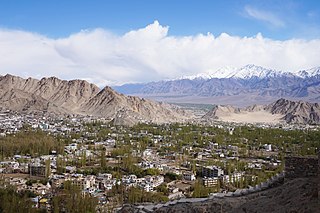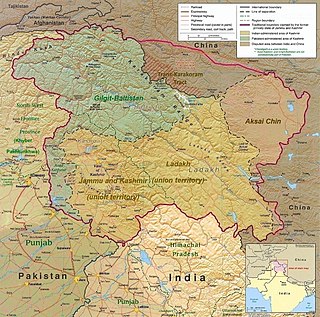
Ladakh is a region administered by India as a union territory, and constitutes a part of the larger Kashmir region, which has been the subject of dispute between India, Pakistan, and China since 1947. Ladakh is bordered by the Tibet Autonomous Region to the east, the Indian state of Himachal Pradesh to the south, both the Indian-administered union territory of Jammu and Kashmir and the Pakistan-administered Gilgit-Baltistan to the west, and the southwest corner of Xinjiang across the Karakoram Pass in the far north. It extends from the Siachen Glacier in the Karakoram range to the north to the main Great Himalayas to the south. The eastern end, consisting of the uninhabited Aksai Chin plains, is claimed by the Indian Government as part of Ladakh, and has been under Chinese control since 1962.

Kargil district is one of the two districts of Ladakh, a region administered by India as a union territory. It spans the entire length of Ladakh in the north–south direction, with Jammu and Kashmir to the west, the Leh district to the east, the Pakistan-administered region of Gilgit–Baltistan to the north and Himachal Pradesh to the south. Encompassing two historical regions known as Purig and Zanskar, the district lies to the northwest of the Great Himalayan range and encompasses the majority of the Zanskar Range. Its population inhabits the river valleys of the Dras, Suru, Kartse, Wakha, and Zanskar rivers.

Dah and Hanu are two villages of the Brokpa of the Leh District of the Indian union territory of Ladakh. Until recently, these were the only two villages where tourists were allowed to visit out of a number of Brokpa villages.

Leh district is a district in the union territory of Ladakh, a territory administered as part of India. With an area of 45,110 km2, it is the second largest district in the country smaller only to Kutch. It is bounded on the north by Gilgit-Baltistan's Kharmang and Ghanche districts and Xinjiang's Kashgar Prefecture and Hotan Prefecture linked via the historic Karakoram Pass. It has Aksai Chin and Tibet are to the east, Kargil district to the west, and Lahul and Spiti to the south. The district headquarters is in Leh. It lies between 32 to 36 degree north latitude and 75 to 80 degree east longitude.

Kargil is a city and a joint capital of the union territory of Ladakh in India. It is also the headquarters of the Kargil district. It is the second-largest city in Ladakh after Leh. Kargil is located 204 kilometres (127 mi) to the east of Srinagar in Jammu and Kashmir, and 234 kilometres (145 mi) to the west of Leh. It is the centre point of the Suru River.

Ladakh has a long history with evidence of human settlement from as back as 9000 b.c. It has been the cross road of high asia for thousands of years and has seen many cultures, empires and technologies taking birth in its neighbours. As a result of these developments Ladakh has imported many traditions and culture from its neighbours and combining them all gave rise to a unique tradition and culture of its own.

The Ladakh Autonomous Hill Development Council, Leh is an Autonomous District Council that administers the Leh district of Ladakh, India.

Tarchit is a village in the Leh district of the Indian union territory of Ladakh. It is located in the Nyoma tehsil.
Kargyam is a village in Leh district of the Indian union territory of Ladakh. It is located in the Durbuk tehsil. Kargyam is famous for its wetlands and Blacknack crane and nomadic lifestyle.

Kumgyam is a village in the Leh district in the Indian union territory of Ladakh. It is located in the Nyoma tehsil.

Himya is a village in the Leh district in the Indian union territory of Ladakh. It is located in the Nyoma tehsil.

Samad Rakchan is a village in the Leh district of the Indian union territory of Ladakh. It is located in the Nyoma tehsil.
Liktse is a village in Leh district of the Indian union territory of Ladakh. It is located in the Nyoma tehsil.

Jamyang Tsering Namgyal is an Indian politician and Member of Parliament from Ladakh, India's largest parliamentary seat geographically. Namgyal was elected, on 9 November 2018, to be the youngest and 8th Chief Executive Councillor (CEC) of Ladakh Autonomous Hill Development Council, Leh. He belongs to the Bharatiya Janata Party (BJP).

Ladakh Police is the police agency responsible for law enforcement and investigations within the Union territory of Ladakh, India. It came into existence on 31 October 2019.

The Emblem of Ladakh is the symbol used to represent the government of Ladakh, a region in the northern part of the Indian subcontinent currently administered by India as a union territory. It was adopted following the creation of the union territory of Ladakh on 31 October 2019.

The Administration of Union Territory of Ladakh(sic) is the governing authority of the Indian union territory of Ladakh and its two districts. The Administration is led by a Lieutenant Governor appointed by the President of India who acts on behalf of the central Government of India. Ladakh does not have an elected legislative assembly. The two districts of Ladakh both elect their own autonomous district council-the Leh Autonomous Hill development council and the Kargil Autonomous Hill development Council, which have competence over a range of domestic affairs.

Politics of Ladakh is exercised within democratic setup of the Indian-administered union territory of Ladakh. Major power centres are Ladakh Autonomous Hill Development Council, Leh and Ladakh Autonomous Hill Development Council, Kargil alongside Ladakh Lok Sabha constituency. Indian National Congress and Bharatiya Janata Party are major political parties. Ladakhi religious organisations like Ladakh Buddhist Association, Imam Khomeni Memorial Trust and Anjuman-e-Jamiat-ul-Ulama Asna Asharia have major influences as well.

The following outline is provided as an overview of and topical guide to Ladakh:

The culture of Ladakh refers to the traditional customs, belief systems, political systems that are followed by Ladakhi people in India. The languages, religions, dance, music, architecture, food, and customs of the Ladakh region are similar to neighboring Tibet. Ladakhi is the traditional language of Ladakh. The popular dances in Ladakh include the khatok chenmo, cham, etc. People of Ladakh also celebrate several festivals throughout the year, some of the most famous are Hemis Tsechu and Losar.











